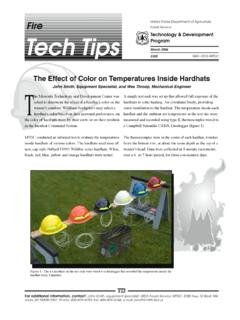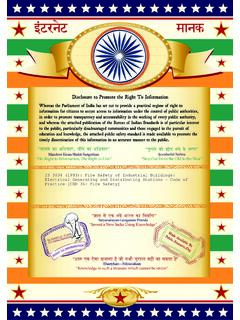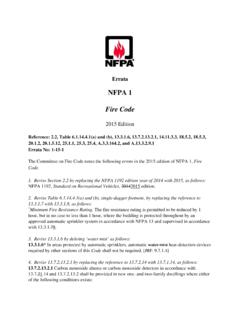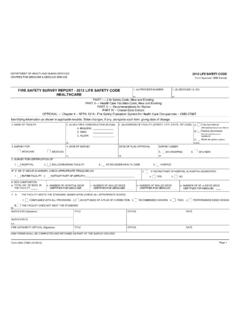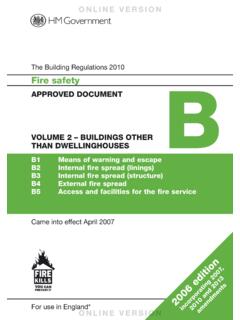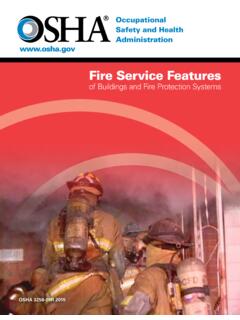Transcription of TEST METHOD 5 CORROSION TESTS Chapter 1. Uniform …
1 TEST METHOD 5 CORROSION TESTSR evised November 24, 2000TM5 1 Chapter 1. Uniform CorrosionGeneral DescriptionPreparation of fire Chemical ProductsCoupon Description and PreparationCoupon Degreasing and Initial CleaningCoupon ImmersionEnd of the Test ExposureFinal Coupon CleaningControl CouponsCalculations of CORROSION RateReplicatesRejection of Individual TestsAveraging of ResultsReporting of ResultsChapter 2. Intergranular CORROSION TestCoupon ExaminationTM5 2 Revised November 24, 2000 TEST METHOD 5 CORROSION TESTSC hapter 1. Uniform CorrosionGeneral DescriptionTest specimens (coupons) of each alloy to be tested,are engraved with a unique identification code,measured to determine dimensions, cleaned toremove grease and oxidation films, rinsed in distilledwater and dried. Each coupon is weighed andimmersed in a test solution in glass jars with screwcaps and placed in an incubator at the testtemperature, undisturbed for 90 days.
2 The couponsare rinsed to remove residual test solution and loosecorrosion products, cleaned with the appropriatesolution and dried. Each coupon is weighed and thechange in weight during immersion is used todetermine the CORROSION of fire Chemical ProductsExcept for TESTS specifically requiring aged or storedchemicals, all test solutions should be freshlyprepared, usually 24 hours before use. fire chemicalproducts are prepared by stirring the wet components(when testing the component) or by adding the wetor dry components to water (when testing mixedretardant) according to manufacturer s viscosity, refractometer values, density, and pHare measured and compared to the manufacturer ssubmission retardant quality control values are acceptable, theretardant is measured into one-quart capacity glassjars. Each jar contains 800 milliliters of test productfor a total immersion test or 400 milliliters of testproduct for a partial immersion test.
3 See figure Figure The retardant is Description and PreparationCoupons of four alloys (2024-T3 aluminum,4130 steel, yellow brass, and Az31B magnesium)are used for evaluation against the Forest Servicewildland fire chemical specifications. See figure are purchased from a commercial source( CORROSION Test Supply, French Settlement,Louisiana). Each coupon is nominally 1 inch by4 inches by 1/8 inch ( cm by cm by cm)with a hole (13/64 inch [ cm] in diameter),centered, 1/2 inch ( cm) from one end of thecoupon. All coupons are purchased unmarked andare stored in the original the laboratory, each coupon is marked, abovethe hole, with a unique identification code using avibrating coupon is then measured, to the cm, in each of the 3 dimensions. The widthand thickness are measured about 1 inch ( cm)from the end that does not have the METHOD 5 CORROSION TESTSR evised November 24, 2000TM5 3 Figure Degreasing andInitial CleaningScotch-Brite scouring pads are cutinto strips about 1 inch by 3 inches( cm by cm) andconditioned to remove excessabrasive by scrubbing a cleancoupon reserved for that conditioning coupon is thesame alloy as the test coupons tobe are degreased byscrubbing with a Scotch-Britescouring pad and Formula 409cleaner.
4 They are then rinsed under cold tap water and cleaned in theappropriate solution shown in table Cleaning Procedures TableALLOYCHEMICAL1 MINUTES TEMPREMARKSA luminum70% HNO32-3 RoomFollow with light scrub(concentrated)using non-metallic brushor scrubbing HCl2-3 RoomFollow with light scrub(half strength)using non-metallic brushor scrubbing SnCl2 + 20g SbC33-5 ColdFollow with light scrubin 1000 mL ofice bathusing non-metallic brushconcentrated HClor scrubbing CrO3 + 1g AgCrO415 BoilingFollow with light scrubin 84 mL ofusing non-metallic brushdistilled H2 Oor scrubbing Cleaning solutions should be discarded as they become used ordiscolored. If in doubt, replace it. When cleaning exposed coupons,special care is needed to prevent erroneous results and in the case ofthe magnesium solution, fresh chemical should be used for If CORROSION film resists cleaning by this procedure alternate with asolution of 2g CrO3+5g3PO4n 93 mL of distilled water heated to 175-185 F (79-85 C) for 10 batch of six coupons (aluminum, mild steel, or brass) is immersedin the specified cleaning solution shown in table in a 600-milliliterplastic beaker.
5 The coupons are arranged, leaning against the inside ofthe beaker, so that the coupons do not touch each magnesium coupon is immersed in cleaning solution in an 8-inch(20 cm) test tube. Several test tubes are placed in a 1-liter beaker, withabout 4 inches (10 cm) of water and glass beads or boiling chips, andthe water heated to boiling on a hot required immersion in the cleaning solution, the coupons areremoved from the solution and scrubbed with a fresh, conditioned scouringpad. The six coupons in a batch are scrubbed with same scouring pad is then used for degreasing new coupons of the same alloy 4 Revised November 24, 2000 TEST METHOD 5 CORROSION TESTSEach scouring pad is used foronly one coupons are rinsed in distilled water, surface waterremoved by wiping with a lint free towel, and the couponssuspended in a drying oven warmed to 125 F (52 C). Do notdry in the same oven (incubator) used to maintain temperaturefor Uniform CORROSION testing.
6 The released chemical vapors mayadversely affect the final CORROSION coupons must be handled withtongs or gloved hands coupons are removed from the oven, allowed to cool forabout 15 minutes, and then weighed to the nearest tenth of amilligram. Coupons should be immersed in test solution soonafter ImmersionA strip of fiberglass-reinforced tape is attached across theopening of the jar and half way down each length of braided dacron fishing line, about 16 inches long, isattached to each coupon by doubling the fishing line and runningthe loop through the hole in the coupon and then running the cutends through the loop. A 15- to 20-pound-test fishing line is firmenough for easy handling but not so firm as to make it difficult dacron line with the attached coupon is twisted over thecenter of the tape so that the coupon is suspended near thecenter of the jar.
7 The loose ends of the fishing line are pulledover the side of the jar and held in place with tape. See coupon is immersed in the test solution in each jar. Couponsfor total immersion TESTS are positioned so that they arecompletely covered with solution but not touching the bottom ofthe jar. Coupons for partial immersion TESTS are positioned sothat the lower 2 inches of the coupon are immersed in theretardant. A small grease pencil tic mark on the edge of thecoupon indicates the proper immersion level. See figure pulp-lined, Bakelite lid is screwed firmly (hand tight) intoplace on the jar. Each jar is labeled with the name and lot numberof the test product, the identification ofthe coupon immersed in the product,and the date of the Coupon in retardant Coupons in jars are then placed into preheatedincubators at the proper temperature,70 F or 120 F (21 C or 49 C), andleft undisturbed during the 90-dayexposure period.
8 See figure Jars in the METHOD 5 CORROSION TESTSR evised November 24, 2000TM5 5 End of the Test ExposureAt the end of the test period, the jarsare removed from the incubators, thejars and contents inspected, and thelids removed. Notes are made of anycracked jars, evaporated testsolution, or coupons that aredestroyed or have pieces test solution is poured from thejar and Coupon CleaningEach coupon is rinsed with a forcefulstream of cold tap water to removeresidual test solution and loosecorrosion products. The coupons arethen allowed to air dry while stillsuspended from the dacron fishingline. After the coupons are dry,usually overnight, the fishing line isremoved. See figure Test solution jars the coupons are dried, any built-up CORROSION products are removedfrom the coupons by scraping withthe flat edge of a stainless steelspatula. In some cases the corrosioninhibitor film must be gently chippedor peeled from the coupon, oncemore using the flat edge of a the CORROSION products andinhibitors are removed the couponsare cleaned in chemical batch of coupons, no more than six, is cleaned along with acontrol coupon that is cleaned in the same manner as the testcoupons.
9 The aluminum, mild steel, and brass coupons are immersedin the cleaning solution, leaning against the sides of the container, a600-milliliter plastic beaker, in such a way that the coupons do nottouch each Final soaking as specified table , each coupon is removedfrom the solution and scrubbed with a fresh, conditioned scouringpad. Clean coupons are rinsed in distilled water, wiped with a lintfree towel, and suspended in the drying oven as previously figure must be taken to scrub and handle each coupon in thesame way. Magnesium coupons are immersed in individual, 8-inch(200 mm) test tubes containing the cleaning solution. Several testtubes are then placed in a 1-liter beaker containing water and glassbeads or boiling chips. The contents of the beaker are heated on ahot plate. Coupons are scrubbed, rinsed, and dried as describedpreviously. Since CORROSION to magnesium coupons often makes theidentification marks difficult to read, care must be taken to maintainthe identity of each coupon during the cleaning and drying persistent residues remain, the coupons may be cleaned a secondtime, again using a control coupon to determine the weight lost duringcleaning.
10 After drying the coupons are cooled and then weighed tothe nearest CouponsControl coupons reserved for this purpose are not exposed to any ofthe test solutions. The control coupons are cleaned and weighedTM5 6 Revised November 24, 2000 TEST METHOD 5 CORROSION TESTS before use; cleaned with a set of exposed coupons;and then weighed again in order to determine theweight loss of the coupon that should be attributedto the cleaning METHOD rather than the exposure totest solution. Each control coupon must be weighedbefore and after of CORROSION RateThe CORROSION rate is calculated for each couponusing the initial and final weights, control weight loss,coupon surface area, and density of the alloy andexposure time in the = 534 [(WtI - WtF) - (WtCI - WtCF)] A t dWhere:WtI= coupon initial weight, mgWtF= coupon final weight, mgWtCI= control coupon initial weight, mgWtCF= control coupon final weight, mgA = surface area of the coupon, in2t = exposure time, hrd = density of the alloy, g/cm3 for 2024-T3 g/cm3 for 4130 g/cm3 for yellow g/cm3 for Az31B magnesiumReplicatesThree replicates will be performed for most TESTS onfresh material.







